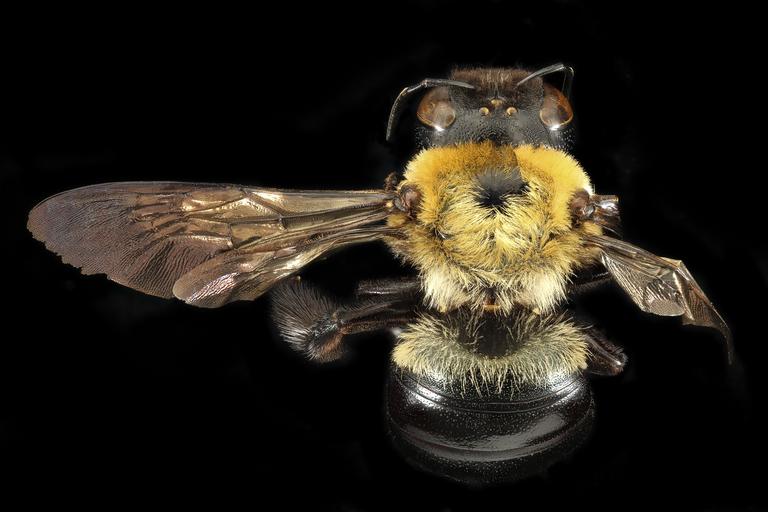MAKE A MEME
View Large Image

| View Original: | Xylocopa_viginica,_f,_back,_Prince_George's_Co,_MD_2016-10-20-18.11.jpg (5760x3840) | |||
| Download: | Original | Medium | Small | Thumb |
| Courtesy of: | www.flickr.com | More Like This | ||
| Keywords: zerene stacker zerenestacker stackshot geological survey geologicalsurvey united states geological survey unitedstatesgeologicalsurvey department of the interior departmentoftheinterior droege biml bee inventory and monitoring laboratory beeinventoryandmonitoringlaboratory bug bugs canon close-up closeup macro insect patuxent wildlife research center patuxentwildliferesearchcenter pwrc usgs dofstacking stacking canon mpe65 canonmpe65 taxonomy:binomial=xylocopa virginica taxonomy:binomial=xylocopavirginica animals animal bee bees apoidea hymenoptera pollinator nativebee maryland prince george's county princegeorgescounty carpenter bee carpenterbee xylocopa black background The Virginia Carpenter bee. The bane of those who build with Cedar Siding, have redwood picnic tables, or who have barns made with softwoods. Other than the recently invaded Lithurgus chrysurus (we certainly will hear more about this wood eater in coming years), this is our only bee int he East that regularly makes holes in wooden structures. These then become family dwellings (do a google search) where there can be little family groups living inside year round. The essentially don't sting and real structural damage (rather than superficial) is rare, but if you want to control them the only way to do that is to plug their holes with water putty or caulk as soon as you find them, otherwise they will reuse and expand their cavities year after year. If you build with rough, soft woods outside you carpenter bees homes, so partially it is your own fault. Photo by Hannah Sutton. Bee from P.G. County, Maryland ~~~~~~~~~~{{{{{{0}}}}}}~~~~~~~~~~ All photographs are public domain, feel free to download and use as you wish. Photography Information: Canon Mark II 5D, Zerene Stacker, Stackshot Sled, 65mm Canon MP-E 1-5X macro lens, Twin Macro Flash in Styrofoam Cooler, F5.0, ISO 100, Shutter Speed 200 Beauty is truth, truth beauty - that is all Ye know on earth and all ye need to know " Ode on a Grecian Urn" John Keats You can also follow us on Instagram - account = USGSBIML Want some Useful Links to the Techniques We Use? Well now here you go Citizen: Art Photo Book: Bees: An Up-Close Look at Pollinators Around the World www.qbookshop.com/products/216627/9780760347386/Bees.html... Basic USGSBIML set up: www.youtube.com/watch?v=S-_yvIsucOY USGSBIML Photoshopping Technique: Note that we now have added using the burn tool at 50% opacity set to shadows to clean up the halos that bleed into the black background from "hot" color sections of the picture. www.youtube.com/watch?v=Bdmx_8zqvN4 PDF of Basic USGSBIML Photography Set Up: ftp://ftpext.usgs.gov/pub/er/md/laurel/Droege/How%20to%20Take%20MacroPhotographs%20of%20Insects%20BIML%20Lab2.pdf Google Hangout Demonstration of Techniques: plus.google.com/events/c5569losvskrv2nu606ltof8odo or www.youtube.com/watch?v=4c15neFttoU Excellent Technical Form on Stacking: www.photomacrography.net/ Contact information: Sam Droege [email protected] 301 497 5840 The Virginia Carpenter bee. The bane of those who build with Cedar Siding, have redwood picnic tables, or who have barns made with softwoods. Other than the recently invaded Lithurgus chrysurus (we certainly will hear more about this wood eater in coming years), this is our only bee int he East that regularly makes holes in wooden structures. These then become family dwellings (do a google search) where there can be little family groups living inside year round. The essentially don't sting and real structural damage (rather than superficial) is rare, but if you want to control them the only way to do that is to plug their holes with water putty or caulk as soon as you find them, otherwise they will reuse and expand their cavities year after year. If you build with rough, soft woods outside you carpenter bees homes, so partially it is your own fault. Photo by Hannah Sutton. Bee from P.G. County, Maryland ~~~~~~~~~~{{{{{{0}}}}}}~~~~~~~~~~ All photographs are public domain, feel free to download and use as you wish. Photography Information: Canon Mark II 5D, Zerene Stacker, Stackshot Sled, 65mm Canon MP-E 1-5X macro lens, Twin Macro Flash in Styrofoam Cooler, F5.0, ISO 100, Shutter Speed 200 Beauty is truth, truth beauty - that is all Ye know on earth and all ye need to know " Ode on a Grecian Urn" John Keats You can also follow us on Instagram - account = USGSBIML Want some Useful Links to the Techniques We Use? Well now here you go Citizen: Art Photo Book: Bees: An Up-Close Look at Pollinators Around the World www.qbookshop.com/products/216627/9780760347386/Bees.html... Basic USGSBIML set up: www.youtube.com/watch?v=S-_yvIsucOY USGSBIML Photoshopping Technique: Note that we now have added using the burn tool at 50% opacity set to shadows to clean up the halos that bleed into the black background from "hot" color sections of the picture. www.youtube.com/watch?v=Bdmx_8zqvN4 PDF of Basic USGSBIML Photography Set Up: ftp://ftpext.usgs.gov/pub/er/md/laurel/Droege/How%20to%20Take%20MacroPhotographs%20of%20Insects%20BIML%20Lab2.pdf Google Hangout Demonstration of Techniques: plus.google.com/events/c5569losvskrv2nu606ltof8odo or www.youtube.com/watch?v=4c15neFttoU Excellent Technical Form on Stacking: www.photomacrography.net/ Contact information: Sam Droege [email protected] 301 497 5840 | ||||